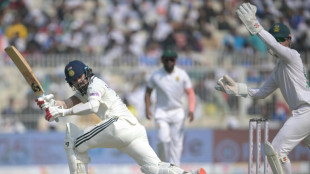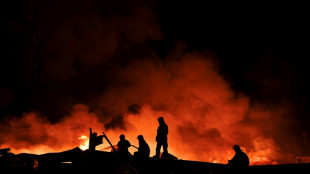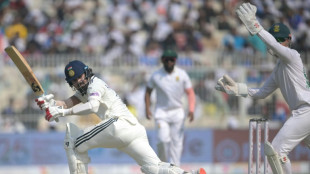
-
 Brazilian 'Superman' cheers child cancer patients in Ghana
Brazilian 'Superman' cheers child cancer patients in Ghana
-
India close in on win over South Africa after Jadeja heroics

-
 Huge explosions rock industrial area near Argentina's capital
Huge explosions rock industrial area near Argentina's capital
-
Bezzecchi takes pole for Valencia sprint and MotoGP

-
 Dominant Shiffrin leads after first slalom run in Levi
Dominant Shiffrin leads after first slalom run in Levi
-
Nine killed in accidental explosion at Indian Kashmir police station

-
 Climate protesters to rally at COP30's halfway mark
Climate protesters to rally at COP30's halfway mark
-
Fighting South Africa lose Rickelton after India 189 all out

-
 Harmer leads South Africa fightback as India 189 all out
Harmer leads South Africa fightback as India 189 all out
-
Prison looms for Brazil's Bolsonaro after court rejects his appeal

-
 EU bows to pressure on loosening AI, privacy rules
EU bows to pressure on loosening AI, privacy rules
-
India close in on lead despite South African strikes

-
 Curry's 49 points propel Warriors in 109-108 win over Spurs
Curry's 49 points propel Warriors in 109-108 win over Spurs
-
NZ boxer Parker denies taking banned substance after failed test

-
 Australia setback as Hazlewood ruled out of 1st Ashes Test
Australia setback as Hazlewood ruled out of 1st Ashes Test
-
Australia pace spearhead Josh Hazlewood ruled out of 1st Ashes Test

-
 UN Security Council to vote Monday on Trump Gaza plan
UN Security Council to vote Monday on Trump Gaza plan
-
Japan's Tomono leads after men's short program at Skate America

-
 China tells citizens to avoid Japan travel as Taiwan row grows
China tells citizens to avoid Japan travel as Taiwan row grows
-
Purdue Pharma to be dissolved as US judge says to approve bankruptcy

-
 Iran's first woman orchestra conductor inspires
Iran's first woman orchestra conductor inspires
-
Wood gets all-clear in boost for England

-
 Golf's world No. 8 Thomas has back surgery
Golf's world No. 8 Thomas has back surgery
-
Rebooted Harlem museum celebrates rise of Black art

-
 'Desperation in the air': immigrant comics skewer Trump crackdown
'Desperation in the air': immigrant comics skewer Trump crackdown
-
UN regulator says shipping still wants to decarbonize -- despite US threats

-
 Grant, Kim share halfway lead in LPGA Annika tournament
Grant, Kim share halfway lead in LPGA Annika tournament
-
Musk's Grokipedia leans on 'questionable' sources, study says

-
 Trump signs order to lower tariffs on beef, coffee, other goods
Trump signs order to lower tariffs on beef, coffee, other goods
-
Croatia qualify for 2026 World Cup, Netherlands close, Germany in limbo

-
 'Last Chance U' coach dies after shooting: US police
'Last Chance U' coach dies after shooting: US police
-
Sinner completes perfect ATP Finals group stage, Auger-Aliassime reaches last four

-
 Woltemade sends Germany past Luxembourg in World Cup qualifier
Woltemade sends Germany past Luxembourg in World Cup qualifier
-
Croatia qualify for 2026 World Cup with 3-1 win over Faroes

-
 Kai Trump makes strides but still misses cut in LPGA debut
Kai Trump makes strides but still misses cut in LPGA debut
-
Return to bad days of hyperinflation looms in Venezuela

-
 US airspace recovers as budget shutdown ends
US airspace recovers as budget shutdown ends
-
Russia strike on Kyiv apartment block kills six, Ukraine says

-
 Arrest made in shooting of 'Last Chance U' coach: US police
Arrest made in shooting of 'Last Chance U' coach: US police
-
At COP30, senator warns US 'deliberately losing' clean tech race with China

-
 US, Switzerland say deal reached on trade and tariffs
US, Switzerland say deal reached on trade and tariffs
-
Fossil fuel lobbyists out in force at Amazon climate talks: NGOs

-
 Returning Alldritt blames himself for France axing
Returning Alldritt blames himself for France axing
-
Stocks struggle on US rates, tech rally fears

-
 A rare oil CEO shows up at COP30, spars with activists
A rare oil CEO shows up at COP30, spars with activists
-
Trump demands probe into Epstein links to Bill Clinton

-
 England great Anderson says 'weak' Australia still Ashes favourites
England great Anderson says 'weak' Australia still Ashes favourites
-
Indigenous protesters disrupt UN climate summit again

-
 Gun salutes for King Charles III as he marks 77th birthday
Gun salutes for King Charles III as he marks 77th birthday
-
Ford urges England to make their own New Zealand history


Amateur astronomers help track asteroid to French impact site
With help from amateur astronomers, scientists tracked how an asteroid travelled from space, broke up in Earth's atmosphere and sent fiery fragments shooting to the ground, gathering new information about how these space rocks disintegrate.
Asteroid 2023 CX1 briefly lit up the sky as it disintegrated over northwestern France at around 4:00 pm (1400 GMT) on February 13, 2023.
Seven hours earlier, a Hungarian astronomer had spotted the small asteroid -- which was less than a metre (yard) wide and weighed 650 kilogrammes (more than 1,400 pounds) -- roughly 200,000 kilometres (125,000 miles) from Earth.
In the following minutes and hours, scientists at NASA and the European Space Agency were able to calculate the location and timeline of its descent with unprecedented accuracy.
Observatories around the world then joined forces to study every aspect of its journey, using a range of scientific instruments.
Among those swiftly mobilising were professional and amateur astronomers from France's FRIPON/Vigie-Ciel network, which launched around a decade ago with a mission to detect and collect meteorites -- the fragments of asteroids that make it to the ground.
"We received dozens of photos and videos" of the asteroid's seconds-long journey through the atmosphere, said meteorite specialist Brigitte Zanda of France's National Museum of Natural History, which is part of the network.
Collaborating with the public -- including sifting through images posted on social media -- allowed scientists to observe the phenomenon with "unmatched precision", Zanda told AFP.
In particular, there was an "extremely useful video showing the object fragmenting, which lets us see how many pieces it broke into -- and how this happened", she said.
- 'Brutal' break-up -
The first meteorite, weighing 93 grams (3.3 ounces), was found two days later in the northwestern French commune of Saint-Pierre-le-Viger with the help of locals.
In all, around a dozen meteorites were collected and added to the museum's collection.
After two-and-a-half years, all the information gathered about the asteroid was published in a study in Nature Astronomy this week.
So far only 11 asteroids have been detected before impact -- and meteorites were only recovered from four of them, said the study.
2023 CX1 likely broke off from a larger rock in the Massalia asteroid family in the asteroid belt between Mars and Jupiter, according to the study.
As the asteroid entered our planet's atmosphere, it disintegrated "very brutally in two stages" around 28 kilometres above Earth, Zanda said.
During the process, it lost 98 percent of its mass -- and released a huge amount of energy.
"This is maybe only the second time we have observed fragmentation like this," Zanda said. "It probably depends on the speed, angle of impact and internal structure of the rock."
None of the fiery meteorites that made it to Earth damaged anything.
However simulations showed that this particular kind of fragmentation has the potential to cause more damage than a more gradual disintegration -- such as the way a much-bigger asteroid exploded over the Russian city of Chelyabinsk in 2013.
As that 20-metre-wide asteroid descended, "there were five successive fragments, each releasing a small amount of energy," Zanda said.
Still, the resulting shockwave shattered windows across the city, injuring more than 1,000 people.
H.Jarrar--SF-PST


